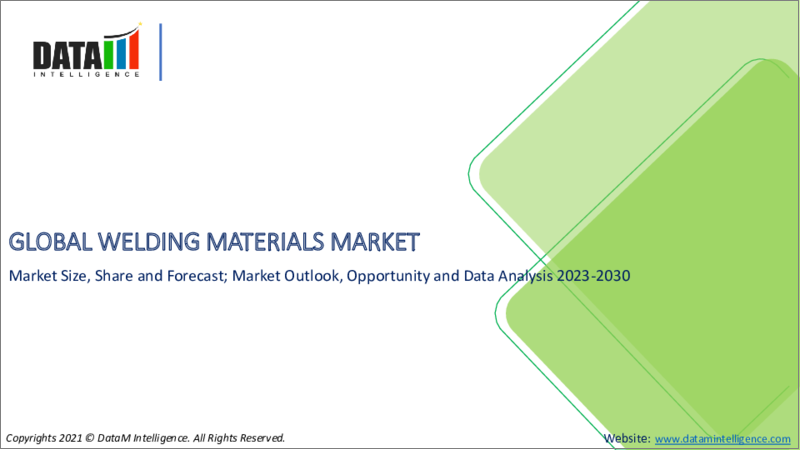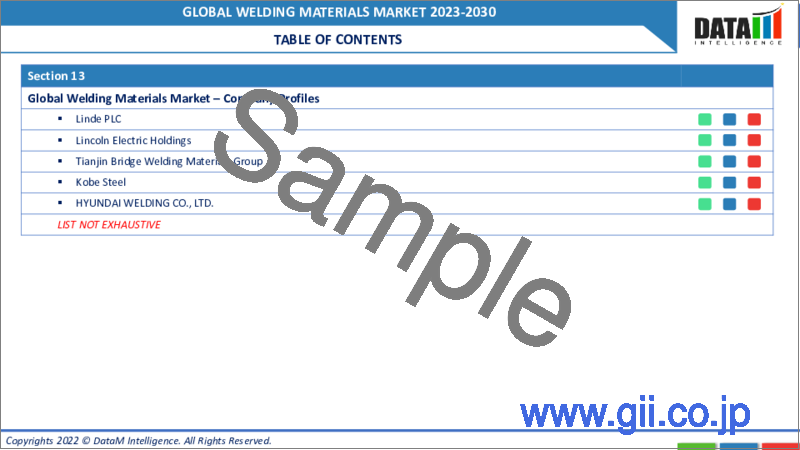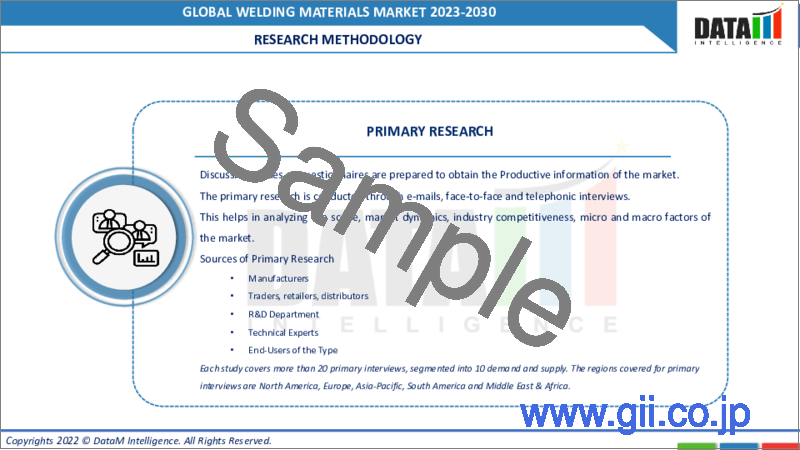|
|
市場調査レポート
商品コード
1316307
溶接材料の世界市場-2023年~2030年Global Welding Materials Market - 2023-2030 |
||||||
カスタマイズ可能
適宜更新あり
|
|||||||
| 溶接材料の世界市場-2023年~2030年 |
|
出版日: 2023年07月27日
発行: DataM Intelligence
ページ情報: 英文 201 Pages
納期: 即日から翌営業日
|
- 全表示
- 概要
- 目次
市場概要
世界の溶接材料市場は2022年に135億米ドルに達し、2023-2030年の予測期間中にCAGR 4.6%で成長し、2030年には173億米ドルに達すると予測されています。
金属部品を組み合わせ、堅固で長持ちする接合部を作るために、溶接材料は構造建築に不可欠な部分です。この部品は、構造の要求に耐え、建物の強度と安全性を確保するように設計されています。フラックス、電極、シールドガスはすべて、溶接継手を製造するための溶接工程で必要となります。
非金属物質である溶接フラックスは、アークや溶接池を周囲の衝撃から遮蔽したり、アーク溶接中のスパッタを低減したりするなど、さまざまな目的で使用されます。ガス溶接では、母材表面の清浄化にフラックスを使用し、エレクトロスラグ溶接では、独特の工学的特性を持つ導電性の溶融物を作るために使用されます。
2022年、溶接材料市場はアジア太平洋が33%以上を占めると予想されます。広大な建設産業がアジア太平洋の溶接材料市場を牽引すると予想されます。Global Construction PerspectivesとOxford Economicsによると、世界の建設生産は2030年までに85%増加し、15兆5,000億米ドルに達すると予想されており、インド、中国、米国が世界拡大の50%以上を占めています。
市場力学
技術開発と建設産業の拡大
レーザー溶接や超音波溶接のような溶接方法の採用が増加しているため、世界の溶接材料市場は拡大しています。溶接は宇宙や水中などの用途に使用できる唯一の接合方法であるため、溶接材料に対するニーズはさらに高まるとみられます。建設部門は近年急速に拡大しています。
インフラプロジェクトへの投資、経済成長、技術進歩のすべてが業界の成長に寄与しています。米国国勢調査局は、2021年4月に全国で176万件の新規住宅建設許可が発行されると予測しています。また、IBEFのデータによると、インドの不動産市場は2025年までに6,500億米ドルを超えると予想されています。
熟練労働者の不足
溶接市場にとって、熟練労働者の確保は不可欠です。溶接分野の専門家は、訓練を受けた溶接工が世界的に不足していると考えています。溶接市場にとって重要な問題は、先進国の人件費の高さです。インフラプロジェクトに携わる請負業者の大半は、溶接・切断機器を使用しており、訓練された溶接工が不足することが多いです。
金属接合技術は、輸送、電力、インフラ(道路、列車、橋など)分野のインフラプロジェクトに欠かせません。インド溶接協会(IIW)によると、2020年には溶接工、切断工、据付工、設備オペレーターが120万人不足します。さらに、2023年には135万人の労働力が不足する可能性があると予測しています。
COVID-19影響分析
工業生産、特に自動車部門と機械部門の減少は、溶接材料の需要に直接影響を与えました。溶接の業界は徐々に雇用を減らしており、これはCOVIDの結果です。経験豊富な溶接工の多くが定年を迎え、若い労働者は金属加工の仕事よりもホワイトカラーの仕事を好むようになっています。
多くの人材が現場に到着できないことは、溶接メーカーにとって事態をより厳しくしました。米国労働統計局の報告によると、深刻な労働力不足にもかかわらず、溶接工やその他関連職の需要は2021年から2023年の間に2%上昇しました。これは、溶接産業が技術の進歩とともに拡大し、進歩し続けることを示唆しています。
ロシア・ウクライナ紛争の影響分析
ロシアとウクライナの紛争は地政学的リスクと不確実性を高め、市場の安定と投資家の信頼に影響を及ぼしています。地政学的環境は、溶接材料の取引や調達方法を変える可能性があります。企業は、紛争リスクを下げるために他のサプライヤーを探す可能性があります。貿易ルートの変更、輸送価格の上昇、溶接材料の供給の遅れは、世界市場に影響を及ぼします。
紛争とその影響により、ロシアとウクライナの両国で経済が不安定になり、投資が減少し、商業的な不確実性が生じています。両国のインフラ、工業、建設産業はいずれも打撃を受けています。その結果、これらの企業では溶接材料のニーズが減少し、それが市場に影響を及ぼしています。
AIによる影響分析
溶接における予測設計を可能にすることで、AIは世界の溶接材料市場にプラスの影響を与えることができます。ロボット工学と自動化は今後、溶接材料市場に大きな影響を与えると思われます。人工知能(AI)、機械学習(ML)、ロボット溶接技術の開発の結果、溶接業界は変化しています。
ロボット溶接システムには、生産性の向上、精度の向上、手頃な価格など、多くの利点があります。システムは反復作業を正確に処理できるため、溶接品質を一定に保つことができます。AIとMLを組み合わせることで、ロボットは学習と適応が可能になり、その能力と生産性が向上します。これらの技術を採用する企業は、業務を合理化し、製造時間を短縮し、リソースをより効果的に管理することができます。
目次
第1章 調査手法と調査範囲
第2章 定義と概要
第3章 エグゼクティブサマリー
第4章 市場力学
- 影響要因
- 促進要因
- 自動車軽量化需要の高まり
- 技術開発と建設産業の拡大
- 抑制要因
- 溶接による環境への悪影響
- 熟練労働者の不足
- 機会
- 影響分析
- 促進要因
第5章 産業分析
- ポーターのファイブフォース分析
- サプライチェーン分析
- 価格分析
- 規制分析
第6章 COVID-19分析
第7章 タイプ別
- 電極・充填材
- フラックス・ワイヤー
- ガス
第8章 技術別
- アーク溶接
- オキシ燃料溶接
- 抵抗溶接
- その他
第9章 エンドユーザー別
- 輸送
- 建設・建築
- 重工業
- その他
第10章 地域別
- 北米
- 米国
- カナダ
- メキシコ
- 欧州
- ドイツ
- 英国
- フランス
- イタリア
- スペイン
- その他欧州
- 南米
- ブラジル
- アルゼンチン
- その他南米
- アジア太平洋
- 中国
- インド
- 日本
- オーストラリア
- その他アジア太平洋地域
- 中東・アフリカ
第11章 競合情勢
- 競合シナリオ
- 市況/シェア分析
- M&A分析
第12章 企業プロファイル
- ESAB
- 会社概要
- 製品ポートフォリオと概要
- 主なハイライト
- 財務概要
- Colfax Corporation
- Air Liquide S.A.
- Air Products & Chemicals
- Illinois Tool Works
- Linde PLC
- Lincoln Electric Holdings
- Tianjin Bridge Welding Materials Group
- Kobe Steel
- HYUNDAI WELDING CO., LTD.
第13章 付録
Market Overview
Global Welding Material Market reached US$ 13.5 billion in 2022 and is expected to reach US$ 17.3 billion by 2030 growing with a CAGR of 4.6% during the forecast period 2023-2030.
In order to combine metal components and make solid, long-lasting connections, welding materials are a vital part of structural building. The components have been designed to withstand the demands of the structure and ensure the strength and security of the building. Fluxes, electrodes and shielding gases are all required throughout the welding process to produce welded joints.
Welding fluxes, which are non-metallic substances, are employed for a variety of purposes, such as shielding the arc and weld puddle from the environment's impacts and reducing spatter during arc welding. Gas welding uses flux to clean the base metal's surfaces, while electro slag welding uses it to create an electrically conducting melt with unique engineering properties.
In 2022, it is expected that the welding materials market would be dominated by Asia-Pacific with more than 33%. The vast construction industry is anticipated to drive Asia-Pacific welding materials market. Global construction production is anticipated to increase by 85% and reach US$ 15.5 trillion by 2030, according to Global Construction Perspectives and Oxford Economics, with India, China and U.S. leading the way and accounting for more than 50% of the global expansion.
Market Dynamics
Technological Development and Expansion of Construction Industry
Owing to the increasing adoption of welding methods like laser and ultrasonic welding, the global welding materials market has grown. The need for welding materials will likely increase further because welding is the only joining method that can be used for applications including those in space and under water. The construction sector has expanded quickly in recent years.
Investments in infrastructure projects, economic growth and technical advancements are all contributing to the industry's growth. U.S. Census Bureau predicts that 1,760,000 new housing permits will be issued nationally in April 2021. Additionally, according to IBEF data, the Indian real estate market is expected to exceed US$ 650 billion by 2025.
Shortage of Skilled Labor
Skilled labour is essential to the welding market. Experts in the welding sector believe that there is a global lack of trained welders. A significant issue for the welding market is the high cost of labour in the industrialised world. The majority of contractors working on infrastructure projects use welding and cutting equipment and they frequently run short on trained welders.
Metal joining techniques are crucial to infrastructure projects in the fields of transportation, power and infrastructure (roads, trains, bridges, etc.). In 2020, there will be a shortage of 1.2 million welders, cutters, fitters and equipment operators, according to the Indian Institute of Welding (IIW). Additionally, it predicted that by 2023, India may have a 1.35 million labour shortfall.
COVID-19 Impact Analysis
A decline in industrial production, particularly in the automotive and machinery sectors, had a direct influence on the demand for welding materials. The industry of welding has gradually reduced employment, which is a result of COVID. Many experienced welders are nearing retirement age, while younger workers now prefer to work for white-collar jobs over metal fabrication jobs.
The fact that many personnel were unable to arrive on site made things much harder for welding manufacturers. U.S. Bureau of Labour Statistics reports that despite the severe labour shortage, demand for welders and other related jobs climbed by 2% between 2021 and 2023. It implies that the welding industry will keep expanding and advancing as technology does.
Russia-Ukraine War Impact Analysis
The conflict between Russia and Ukraine has increased geopolitical risk and uncertainty, which has an effect on market stability and investor confidence. The geopolitical environment may change the ways that welding materials are traded and sourced. Businesses could search for other suppliers to lower the risk of the conflict. Changes in trade routes, higher transportation prices and delays in the supply of welding supplies have an effect on the global market.
The conflict and its fallout have caused economic instability, a decline in investment and commercial uncertainty in both Russia and Ukraine. The infrastructure, industrial and construction industries in these countries have all been harmed. As a result, these businesses have less need for welding materials, which has an impact on the market.
AI Impact Analysis
By enabling predictive designs in welding, AI can positively affect the global welding materials market. Robotics and automation will have a major impact on the market for welding materials in the future. The welding industry is changing as a result of developments in artificial intelligence (AI), machine learning (ML) and robotic welding technologies.
Many advantages come with robotic welding systems, such as increased production, accuracy and affordability. The systems are capable of handling repetitive jobs accurately, which leads to constant weld quality. Robots can learn and adapt by combining AI and ML, which improves their capabilities and productivity. Businesses that adopt these technologies can streamline operations, shorten manufacturing times and more effectively manage resources.
Segment Analysis
The global welding materials market is segmented based on type, technology, end-user and region.
Growing Welding in Structural Infrastructure
The construction & building end-user segment, which is the largest, is projected to account for more than 1/4th share of the global welding materials market. Welding is typically used for structural purposes when building infrastructure. The reason for this happens because the majority of structures built in this industry are megastructures that rely on strong metal frames made by welding.
Steel, in particular, may be used to construct some infrastructure, such as bridges, virtually entirely. The players are working to create new welding materials to suit the demand since the construction industry has a variety of welding needs. For instance, Lincoln Electric unveiled new GTAW (TIG) cut lengths in 2020 that have high silicon compositions and stainless steel alloys for a precise and high-quality welding process.
Geographical Analysis
Growing Infrastructure Projects in North America
Due to the significant penetration of cutting-edge welding materials technology for the region's building & construction and automotive industries, the North America welding materials market is expected to account for about 1/3rd of the global market during the forecast period. The need for welding in North America is anticipated to expand as infrastructure projects progress.
For instance, the Southwest Florida International Airport will spend US$ 250 million in 2023 to expand its terminal to accommodate additional checkpoints and check-in sections that need metals and blocks to be fixed and welded at specific locations. It is expected to increase demand for welding materials and fuel market expansion in the region.
Competitive Landscape
The major global players include: ESAB, Colfax Corporation, Air Liquide S.A., Air Products & Chemicals, Illinois Tool Works, Linde PLC, Lincoln Electric Holdings, Tianjin Bridge Welding Materials Group, Kobe Steel and HYUNDAI WELDING CO., LTD.
Why Purchase the Report?
- To visualize the global welding materials market segmentation based on type, technology, end-user and region, as well as understand key commercial assets and players.
- Identify commercial opportunities by analyzing trends and co-development.
- Excel data sheet with numerous data points of welding materials market-level with all segments.
- PDF report consists of a comprehensive analysis after exhaustive qualitative interviews and an in-depth study.
- Product mapping available as excel consisting of key products of all the major players.
The global welding materials market report would provide approximately 61 tables, 59 figures and 201 pages.
Target Audience 2023
- Manufacturers/ Buyers
- Industry Investors/Investment Bankers
- Research Professionals
- Emerging Companies
Table of Contents
1. Methodology and Scope
- 1.1. Research Methodology
- 1.2. Research Objective and Scope of the Report
2. Definition and Overview
3. Executive Summary
- 3.1. Market Snippet By Type
- 3.2. Market Snippet By Technology
- 3.3. Market Snippet By End-User
- 3.4. Market Snippet By Region
4. Dynamics
- 4.1. Impacting Factors
- 4.1.1. Drivers
- 4.1.1.1. Rising Demand for Lightweight Automotives
- 4.1.1.2. Technological Development and Expansion of Construction Industry
- 4.1.2. Restraints
- 4.1.2.1. Harmful Impact on Environment Due to Welding
- 4.1.2.2. Shortage of Skilled Labor
- 4.1.3. Opportunity
- 4.1.4. Impact Analysis
- 4.1.1. Drivers
5. Industry Analysis
- 5.1. Porter's Five Force Analysis
- 5.2. Supply Chain Analysis
- 5.3. Pricing Analysis
- 5.4. Regulatory Analysis
6. COVID-19 Analysis
- 6.1. Analysis of COVID-19
- 6.1.1. Scenario Before COVID
- 6.1.2. Scenario During COVID
- 6.1.3. Scenario Post COVID
- 6.2. Pricing Dynamics Amid COVID-19
- 6.3. Demand-Supply Spectrum
- 6.4. Government Initiatives Related to the Market During Pandemic
- 6.5. Manufacturers Strategic Initiatives
- 6.6. Conclusion
7. By Type
- 7.1. Introduction
- 7.1.1. Market Size Analysis and Y-o-Y Growth Analysis (%), By Type
- 7.1.2. Market Attractiveness Index, By Type
- 7.2. Electrodes & Filler Materials*
- 7.2.1. Introduction
- 7.2.2. Market Size Analysis and Y-o-Y Growth Analysis (%)
- 7.3. Fluxes & Wires
- 7.4. Gases
8. By Technology
- 8.1. Introduction
- 8.1.1. Market Size Analysis and Y-o-Y Growth Analysis (%), By Technology
- 8.1.2. Market Attractiveness Index, By Technology
- 8.2. Arc Welding*
- 8.2.1. Introduction
- 8.2.2. Market Size Analysis and Y-o-Y Growth Analysis (%)
- 8.3. Oxy-Fuel Welding
- 8.4. Resistance Welding
- 8.5. Others
9. By End-User
- 9.1. Introduction
- 9.1.1. Market Size Analysis and Y-o-Y Growth Analysis (%), By End-User
- 9.1.2. Market Attractiveness Index, By End-User
- 9.2. Transportation*
- 9.2.1. Introduction
- 9.2.2. Market Size Analysis and Y-o-Y Growth Analysis (%)
- 9.3. Construction & Building
- 9.4. Heavy Industries
- 9.5. Others
10. By Region
- 10.1. Introduction
- 10.2. Market Size Analysis and Y-o-Y Growth Analysis (%), By Region
- 10.3. Market Attractiveness Index, By Region
- 10.4. North America
- 10.4.1. Introduction
- 10.4.2. Key Region-Specific Dynamics
- 10.4.3. Market Size Analysis and Y-o-Y Growth Analysis (%), By Type
- 10.4.4. Market Size Analysis and Y-o-Y Growth Analysis (%), By Technology
- 10.4.5. Market Size Analysis and Y-o-Y Growth Analysis (%), By End-User
- 10.4.6. Market Size Analysis and Y-o-Y Growth Analysis (%), By Country
- 10.4.6.1. U.S.
- 10.4.6.2. Canada
- 10.4.6.3. Mexico
- 10.5. Europe
- 10.5.1. Introduction
- 10.5.2. Key Region-Specific Dynamics
- 10.5.3. Market Size Analysis and Y-o-Y Growth Analysis (%), By Type
- 10.5.4. Market Size Analysis and Y-o-Y Growth Analysis (%), By Technology
- 10.5.5. Market Size Analysis and Y-o-Y Growth Analysis (%), By End-User
- 10.5.6. Market Size Analysis and Y-o-Y Growth Analysis (%), By Country
- 10.5.6.1. Germany
- 10.5.6.2. UK
- 10.5.6.3. France
- 10.5.6.4. Italy
- 10.5.6.5. Spain
- 10.5.6.6. Rest of Europe
- 10.6. South America
- 10.6.1. Introduction
- 10.6.2. Key Region-Specific Dynamics
- 10.6.3. Market Size Analysis and Y-o-Y Growth Analysis (%), By Type
- 10.6.4. Market Size Analysis and Y-o-Y Growth Analysis (%), By Technology
- 10.6.5. Market Size Analysis and Y-o-Y Growth Analysis (%), By End-User
- 10.6.6. Market Size Analysis and Y-o-Y Growth Analysis (%), By Country
- 10.6.6.1. Brazil
- 10.6.6.2. Argentina
- 10.6.6.3. Rest of South America
- 10.7. Asia-Pacific
- 10.7.1. Introduction
- 10.7.2. Key Region-Specific Dynamics
- 10.7.3. Market Size Analysis and Y-o-Y Growth Analysis (%), By Type
- 10.7.4. Market Size Analysis and Y-o-Y Growth Analysis (%), By Technology
- 10.7.5. Market Size Analysis and Y-o-Y Growth Analysis (%), By End-User
- 10.7.6. Market Size Analysis and Y-o-Y Growth Analysis (%), By Country
- 10.7.6.1. China
- 10.7.6.2. India
- 10.7.6.3. Japan
- 10.7.6.4. Australia
- 10.7.6.5. Rest of Asia-Pacific
- 10.8. Middle East and Africa
- 10.8.1. Introduction
- 10.8.2. Key Region-Specific Dynamics
- 10.8.3. Market Size Analysis and Y-o-Y Growth Analysis (%), By Type
- 10.8.4. Market Size Analysis and Y-o-Y Growth Analysis (%), By Technology
- 10.8.5. Market Size Analysis and Y-o-Y Growth Analysis (%), By End-User
11. Competitive Landscape
- 11.1. Competitive Scenario
- 11.2. Market Positioning/Share Analysis
- 11.3. Mergers and Acquisitions Analysis
12. Company Profiles
- 12.1. ESAB
- 12.1.1. Company Overview
- 12.1.2. Product Portfolio and Description
- 12.1.3. Key Highlights
- 12.1.4. Financial Overview
- 12.2. Colfax Corporation
- 12.3. Air Liquide S.A.
- 12.4. Air Products & Chemicals
- 12.5. Illinois Tool Works
- 12.6. Linde PLC
- 12.7. Lincoln Electric Holdings
- 12.8. Tianjin Bridge Welding Materials Group
- 12.9. Kobe Steel
- 12.10. HYUNDAI WELDING CO., LTD.
LIST NOT EXHAUSTIVE
13. Appendix
- 13.1. About Us and Services
- 13.2. Contact Us






